Gyeongju
A trip to South Korea has been on the books for me for many years. But if I was going to do the country justice, I wanted to see a bit more of it than just Seoul in the north.
It led to my plans to travel around the country by train (similar to my time in Japan previously), making three or four stops along the way. Hours of research later and I’d outlined a route that I wanted to take. My South Korean adventure was coming to life!
Starting off in Seoul in October, my friend (Joe) and I made the trip to Gangneung on the east coast of the country before making the journey south to Busan. But before we’d get to the coastal city we also were set for a two-night stay in a destination I was excited to see due to its fantastic mix of modern attractions and culture; the city of Gyeongju.
Located in the south-east of South Korea, the ancient city of Gyeongju remains somewhat off the average visitors’ itinerary.
Yet, while this intriguing city does not have the size – or indeed the pulling power – of the nation’s capital, there are a growing number of tourists dropping it into their plans for a nationwide sweep of the southern part of Korea.

A key reason for this, it can be deduced, is that the city holds more temples, pagodas, tombs, palaces, gardens and Buddhist statuaries than any other place within the country.
Situated in the province after Andong, Gyeongju is home to almost 275,000 people as well as an impressive three UNESCO World Cultural Heritage sites.
The history of this region dates back through the centuries when Korea was split into three kingdoms. Gyeongju, in its position in the south, became the capital of one of those kingdoms; Silla.
Silla, alongside the Kingdoms of Baekje and Goguryeo covered the land that now makes up what we know today as North and South Korea.
Lasting almost a thousand years (57 BC – 935 AD), Silla played an important role shaping the Korean Peninsula and its people’s heritage before eventually falling to the Goryeo rule which, briefly, unified the whole of Korea. Sadly, unification of Korea remains somewhat a pipe-dream even in this modern era.
So what should a first time traveller to Gyeongju – and indeed South Korea – know before setting off?
The first thing to take note of is the currency. South Korea use the South Korean Won which, at the time of writing, was worth approximately 1,500 Won to £1. Credit cards are also widely accepted throughout the country.

Language is an obstacle here. While a lot of South Korean people have a grasp (to varying degrees) of English, there are a lot that don’t. So be prepared for some rather disjointed social interactions. It would be good, however, to arm yourself with as many basic Korean words as you can as it will smooth over some of the awkwardness.
A good start is the word for hello or hi. In Korean this is annyeonhaseyo. Bit of a mouthful, but it can be broken down phonetically into sections like ‘ann’ ‘yong’ ‘ass’ and finally ‘ayo’.
As, I’ve experienced also, a lot of Koreans who don’t feel comfortable speaking in another language (as is understandable) will chose to simply avoid you and will, politely, usher you away to avoid social embarrassment on both parties behalves.
However, there is also an unfortunate section of Korean society that just seemed closed off to foreigners. I remember on more than one occasion my friend and I tried to enter a bar or karaoke joint (in Gyeongju as well as other locations in South Korea including Seoul and Busan) and were blocked from entering as they claimed they were full (more on this later on). This I’d have accepted a bit more had they not then let Korean people enter unobstructed!
In one bar we were simply told we were not coming in because they had a policy of “no foreigners”. At least they were honest I guess.
That, was my only mini gripe with Korea as the vast majority of people we encountered were friendly, hospitable and welcoming and made our stay extremely enjoyable.
In fact, during our stay in Gyeongju, Joe and I became mini-celebrities (or so it felt like) on a couple of occasions as we were ushered into photos with groups of local tourists.
The first time it happened we were cycling through a street when a bus driver pulled over and asked if his coach full of tourists could have photos with us. We obliged, although did feel slightly awkward at first when random strangers were getting off the bus to stand with their arms around us, but soon enough we got into the swing of it. Those who took photos with us towards the end probably ended up getting better shots as we were no longer looking confused by the whole situation.
The second time it happened we were in a theme park (more on that later in the blog) and a group of Korean schoolgirls nervously asked us if we would have pictures taken with them. Again we did so, although this time with a lot less physical contact!
The next thing to note is the time difference. From the UK to South Korea there is either an eight or nine hour time difference (South Korea being in front of the UK as it is much further east).
Flying to South Korea is a tiring experience and often you’ll leave the UK on one day and then lose the hours for the time difference and arrive during the next day; meaning you’ll have missed a night’s sleep and have serious jet-lag. If you’re anything like me this can affect you for a few nights’ sleep after you arrive. Just bear that in mind when you’re waking up at 3am ready for the day ahead.
For those looking to explore South Korea who have spent time in parts of Japan at a similar time of year (October) you can expect South Korea to be a few degrees cooler than their Japanese counterparts.
From my time in Gyeongju, temperatures ranged from around highs of 20°C to lows of 12°C. It’s a pretty comfortable climate and certainty t-shirt weather when the sun is out. However, take note, it does rain a fair bit also, so pack some wet-weather gear.
A final point to consider is about being online while you’re out and about. If you have a standard European sim-card in your phone, it’s highly unlikely you’ll get free data in South Korea.
For this issue we decided to rent a portable Wi-Fi unit. We did this from the easy-to-use and helpful KT Roaming.
I booked a device for nine days (total length of my time in South Korea before we moved on to Japan). Having arrived at Seoul Incheon International Airport I was able to collect the kit after coming through immigration.
Better yet, as we weren’t flying out of South Korea from Seoul, we were also able to drop off our unit at Gimhae International Airport in Busan. It was very easy to organise and the portable Wi-Fi gave us easy access to the internet for the entirety of our trip, which helped us to navigate our way around South Korea.
The cost was incredibly cheap as well. For just 8,800 Won a day (around £6) the total bill came to 79,200 Won for nine days (about £54). Even better, for some reason I’m still not sure about, I got an online discount which knocked a further 39,600 Won off the bill (about £27) making the whole thing half-price! Pays to book online in advance it seems.
So why visit Gyeongju? Well unlike Seoul, which is a huge city spanning as far as the eye can see, Gyeongju offers a calmer, more authentic view of Korean life. It has the right mix of cultural sites alongside other modern elements. In this blog I’ll take a look at both sides of this Korean coin.

Summing up Gyeongju, it feels like a trip to living history. With so many artefacts spanning centuries, the city is a melting pot of intrigue. Antiquity and modern culture meld together seamlessly, so much so, that it’s hard to see where the past ends and the modern day begins.
As a cultural hub, for those venturing to South Korea, the city of Gyeongju – and the surrounding region – could end up being the most interesting place to visit that most people have probably never heard of.
Getting there
Getting to Gyeongju, from the UK, is not a direct trip. Firstly there is no airport in Gyeongju. The closest international airport is in Busan (Gimhae International Airport), however, this airport also doesn’t connect with UK airports at the moment.
The UK to South Korea is still not a well trodden route for British holidaymakers, so flights are less common (although not hard to find) than flights to Japan or China may be. However, all your flights are likely (if you are going direct) to be landing in the South Korean capital; Seoul.
It means travellers looking to get to Gyeongju will fly to Seoul (Incheon International Airport) from London Heathrow using one of three airlines; Asiana Airlines, Korean Air or British Airways. For our trip, Joe and I went with the latter; booked via Travel Trolley for a modest £608.31 return per person. Good value for such a long trip.
As you’d expect from a British Airways flight of this length (flight time is between 11 and 12 hours), you get a couple of meals and a variety of drinks options while onboard. There is also a good selection of films, TV shows, music and games to choose from to pass the time.

Seoul Incheon is a behemoth of an airport. It’s huge! Every year around 71 million passengers pass through its gates to travel all over the world. There are two main terminals here so make sure you know which one you are flying out of when you leave as it could cause you an issue if you’re tight for time and end up at the wrong one.
Once Joe and I disembarked the plane we made our way through the immigration procedures and, after about an hour, found ourselves on the other side of their border control and in South Korea.
One thing to remember is that Incheon International Airport is a long way outside of the centre of Seoul (about 49km). For me the best bet here is to get the Metro which is conveniently located at the airport.
The Airport Railroad Express (AREX) provides two different trains from the airport to Seoul; the Express Train and the All Stop train. The Express train runs directly from Incheon International Airport to Seoul in just 40 minutes and costs 9,500 won (about £7). The All Stop train stops at different stations along the way until it reaches Seoul Station, including Myeondong, Hongdae and Itaewon. The total journey time for this train is 60 minutes and tickets cost 4,150 won (about £3.50).
Now, if you’re travelling as we did, you’ll spend some time in Seoul first of all (we spent three nights here) before heading off to other locations in the country. When it’s time to leave Seoul, head to Seoul Station in the heart of the city (on metro lines 1 and 4 – dark blue and light blue respectively).
From Seoul take the high-speed train to Gyeongju; changing at Dongdaegu Station in Daegu. The whole journey time will be around three and a half to four hours, depending on how long you have to spend in Daegu. To work out our route I used the helpful Navitime Transit website as Google Maps seem a bit blind when it comes to South Korean travel options.
Final point to note is when you buy your tickets (as is the case in Japan) you’ll get the option to buy a set-seat on a certain train or to try and get a seat with those who don’t chose this option. This obviously affects the price, but it’s worth spending the extra bit of money to avoid any issues of not being able to get a seat.
Where to stay
When we arrived at the train station in Gyeongju, we didn’t know much about the layout of the city or where our hotel for the next two nights was located. A quick Google search later found that we were about a 30 minute walk away from our destination; the Gyeongju Tourist Hotel GG that I’d booked via Agoda.com.
From the outside I wasn’t expecting much. The hotel is set a little way back off a main road (Taejong-ro) next to a small American-style eatery called A Twosome Place and a McDonald’s restaurant.
However, when we got inside and checked into our room I was pleasantly surprised by how nice it was.
As hotel room prices around Korea feel cheaper than in the UK – or even in Japan – we were able to buy one of their more expensive rooms (the Royal Suite) for just £190.65 in total (just £95.33 per night).
For that we got a spacious living area with comfortable seats and sofas and a large flat screen TV on the wall. In the bedroom we were welcomed by two, large comfortable, double beds and another huge TV to watch while in bed.
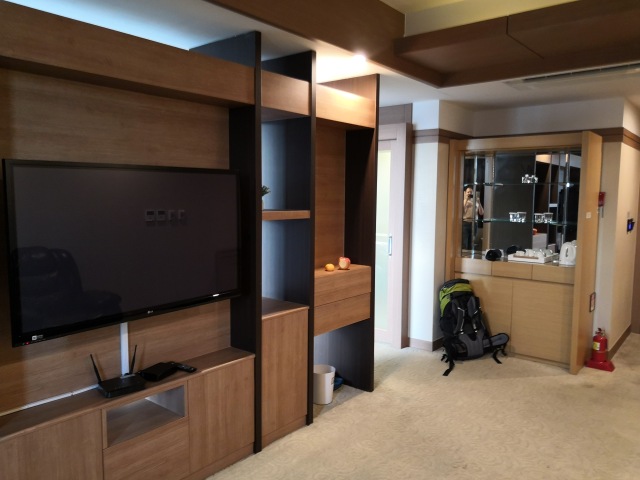
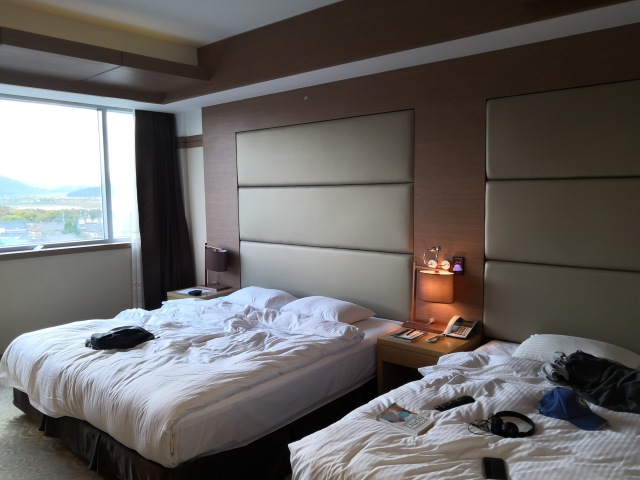

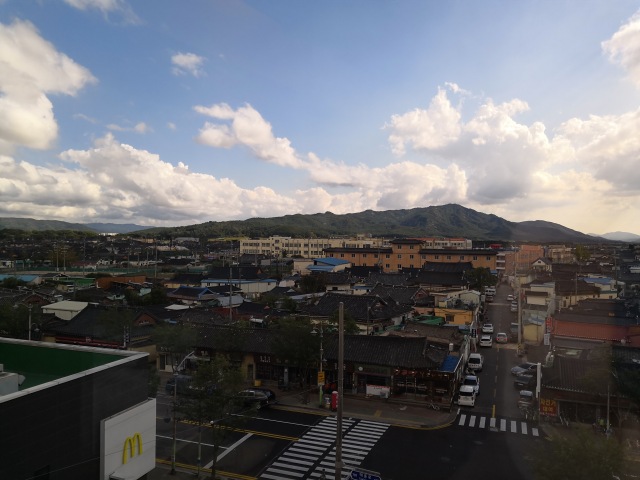
Just off from the bedroom there was a well-designed, clean, bathroom that was complete with both bath and shower facilities.
The one thing that was lacking from the booking was breakfast. Despite having one of the better rooms we didn’t get breakfast in the hotel so both days of our stay we popped into the McDonald’s just outside to get a bite to eat before heading off on our days out.
Getting around
When you arrive in Gyeongju you’ll come into the train station which, as mentioned earlier, is about a 30 minute walk from Gyeongju Tourist Hotel GG.
If you are too tired to walk there are also bus routes available that get you closer to the hotel. These options include red routes 10, 153, 300-1, 304 or blue routes 51, 260, 301, 335, 337, 607. If possible, ask the bus driver to point out to you which stop you should get off at.
Unlike Seoul, getting around in Gyeongju is pretty easy to do by foot. A lot of the central sites are easily located and in close proximity to one another. If, however, you are visiting some of the sites on the outskirts of the city then it’s best to speak to the hotel reception, or tourist information centre, for ideas on which busses to catch. Failing that, as we did on a couple of occasions when we were feeling lazy, catch a taxi.
If you feel like seeing the city, and doing some exercise at the same time, there are plenty of opportunities to rent bikes in Gyeongju.
Joe and I did this for an afternoon and used a bike rental shop opposite our hotel on Taejong-ro.



While I cannot remember the exact price of renting these bikes, they were extremely affordable. I certainly don’t recall feeling ripped off even though the saddle on one of the two bikes was very loose.
Riding around the city on the roads is pretty safe. So long as you are sensible you shouldn’t experience any issues. Worth noting however, that you won’t be able to take your bikes into historical areas, so you’ll have to find somewhere to lock them up before going inside.
Top sites
As previous mentioned, the region of Gyeongju is home to three UNESCO World Cultural Heritage sites; Yangdong Village, Bulguksa Temple and the Gyeongju Historic Areas.
The first of those sites is Yangdong Village. Founded by Son So, in the 1400s, it is the birthplace of the lineage that produced one of the eighteen sages of Korea; Yi Unjeok.
Today the village still stands and has over 160 tile-roofed and thatched-roof homes built throughout the dense forest. Impressively, 54 homes that are over 200 years old have also been preserved allowing future generations to marvel at this site of historic value.
There is a bus (number 203 I believe) that will take you to the village in about 40 minutes. Check with an information centre in the city for up-to-date timetables and bus stop locations. Once at the village it will cost you about 4,000 Won (about £2.70) per person to enter.
Moving outside the city again – this time onto the slopes of Mount Toham – travellers will find the second UNESCO site and one of the head temples of the Jogye Order of Korean Buddhism; Bulguksa Temple.
Bulguksa was built in 528 AD, when Buddhism was officially accepted in the region and now houses no fewer than seven national treasures of South Korea including the Dabotap and Seokgatap stone pagodas and the Cheongungyo (Blue Cloud Bridge) and Baegungyo (White Cloud Bridge).
For Bulguksa Temple, and the nearby Seokguram grotto, the entrance fee for an adult is 5,000 Won (or about £3.30) per adult.
To visit the temple, travel on either buses 10 or 11 from the Gyeongju Station or the Gyeongju Intercity/Express Bus Terminal.
While the unification of Korea spelled the end of the Silla rule, the change in administration didn’t cause the end of the fallen kingdom’s history.
Evidence of this once mighty kingdom can still be seen all around the region – including in central Gyeongju – and perhaps none of this kingdom’s impressive history is more apparent than when you visit the famous Daereungwon Tomb Complex (the Royal Burial Grounds) in the heart of the new city.
These burial grounds also form a significant part of the third, and final, UNESCO World Heritage Sites in Gyeongju in the aptly named Gyeongju Historic Areas.
Gyeongju was seen as the capital of the ancient kingdom of Silla and it became a site of great importance for the Kingdom’s many rulers. When death came, these kings and queens wanted to be remembered appropriately. The desire to be immortalised heralded the creation of what is now known as the Daereungwon Tomb Complex; part of the modern-day, Tumuli Park Belt.
The Tumuli Park Belt consists of three groups of royal tombs. Known as the Daereungwon Area in Korean. The name “Daereungwon” came from a history book, History of Three Kingdoms, which states: “King Michu was buried in Daereung.”
The belt is the final resting place of numerous high-ranking figures including kings, queens and aristocrats. By section, the clusters of tombs are separately called Hwangnamri, Nodongri and Noseori.
The belt is easily identifiable. From the outside these large grassy mounds that look like small hillocks, encompass a tomb – or tumuli. Under the earth, these graves are surrounds by small stone chambers – where the coffin would be placed alongside artifacts from the deceased’s life – before being covered to signify their position.
Over the years, the valuable relics placed inside the tumuli have been excavated from the tombs. These finds included golden crowns, glass cups, various types of earthenware and the Cheonmado painting (Painting of a Heavenly Horse).
The latter of these finds was discovered in Cheonmachong Tomb which you can enter and see. Excavated in 1973, Cheonmachong Tomb consists of a wooden coffin placed inside an underground chamber mounded with boulders and earth.
At a height of 12.7m and a diameter of 50m, the mound consists of a layer of rocks collected from streams. Below the rock layer is a wooden chamber that measures at 6.5m long and 2.1m wide, reaching 2.1 m in height which is where the painting was created.
Since its discovery, a total of 11,526 artefacts have been found within this tomb alone, including the Cheonmado painting; an artwork considered highly valuable as it is Korea’s first artwork to be excavated from an ancient tomb.
It is, of course, just one example of such a tomb in the Belt. There are hundreds and visitors get the chance to walk freely around, what has been described as ‘the world’s largest museum without walls’, once they’ve paid for a ticket at the entrance-way.
One final, noticeable, landmark in the area is the Cheomseongdae; a small stone tower that looks similar to a British bottle-kiln. This tower, however, was not for pottery, but instead for astronomy (Cheomseongdae translates as star gazing tower from Korean). It remains significant because it is the oldest surviving astronomical observatory in Asia, and possibly even the world, having been constructed in the 7th Century.
The entrance to the Tumuli Park Belt is 1,500 won (or about about £1) per person and the entrance can be found in the centre of the city itself, off the main Taejong-ro road. You are not allowed to take bikes inside the Belt so bear this in mind when you plan to visit.

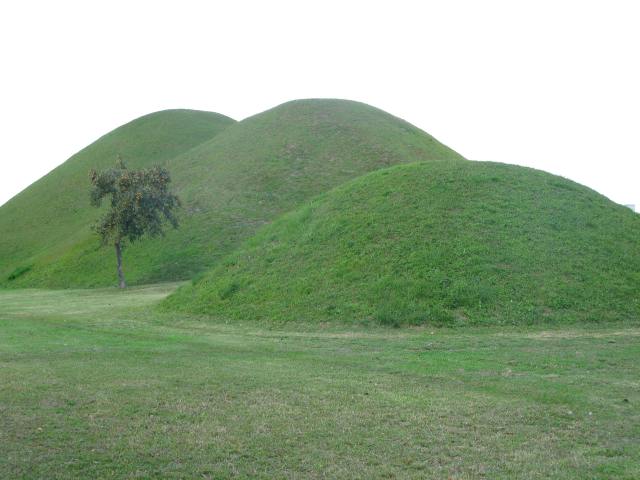
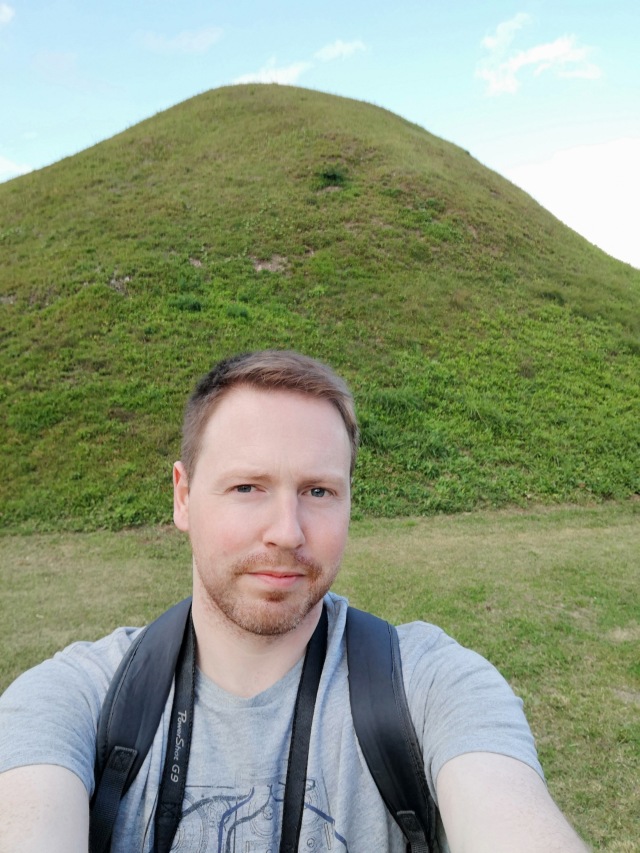

The next place to visit is either a short walk, or cycle ride, from the Tumuli Park Belt.
Located down Wonhwa-ro, Donggung Palace and Wolji Pond is stunning example of Korean architecture and is a part of Gyeongju National Park.
The palace and pond (which is man-made) were formerly known as Anapji. They date back to the year 674 when it was built, by order, of King Munmu of the Silla Kingdom.
Inside the complex, visitors can walk around the impressive gardens, see the pond and the palace and enjoy the tranquillity this typically Korean area provides.
Joe and I actually came across it by chance during our stay. We were cycling around and asked a Korean woman where we could get the best views of the city from within the city itself. We were looking for somewhere high up that afford a great vista, but I think this got lost in translation.
We were told the ‘highest’ views in Gyeongju were from this Palace so we thanked our helpful guide and made our way to the site. However, it appears that our friendly guide confused the term ‘highest’ for ‘prettiest’ as the palace and pond are both very much at ground level.
It really didn’t mater though as the views within the grounds were more than worth the journey and modest admission fee of 3,300 Won per adult (about £2.50).
Final tip here – and one I’d really wish we’d taken ourselves – is to visit (or even revisit) this site at night as they light up the palace which creates amazing reflections on the pond and great photo opportunities.

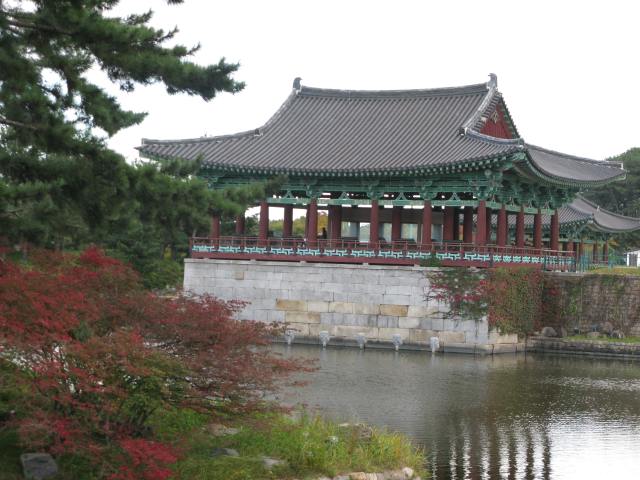
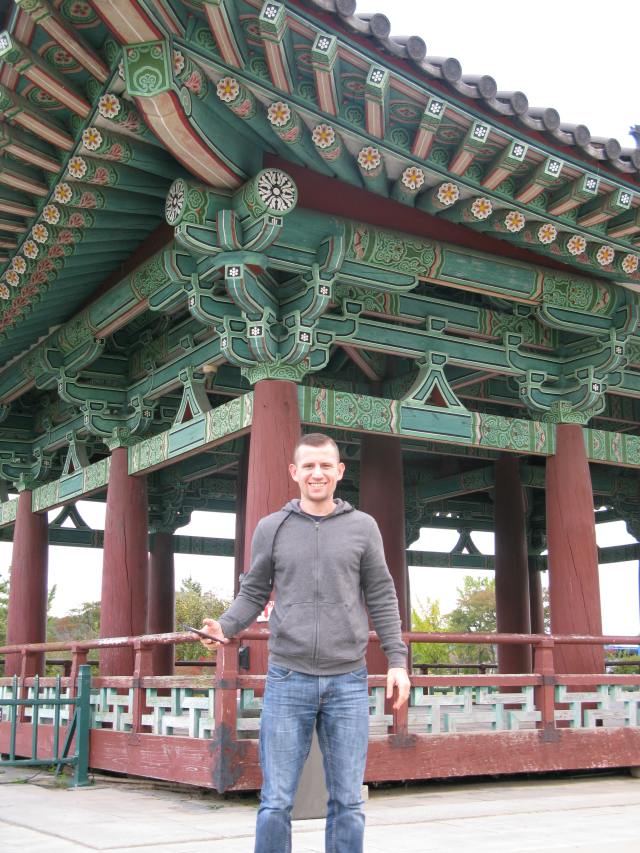
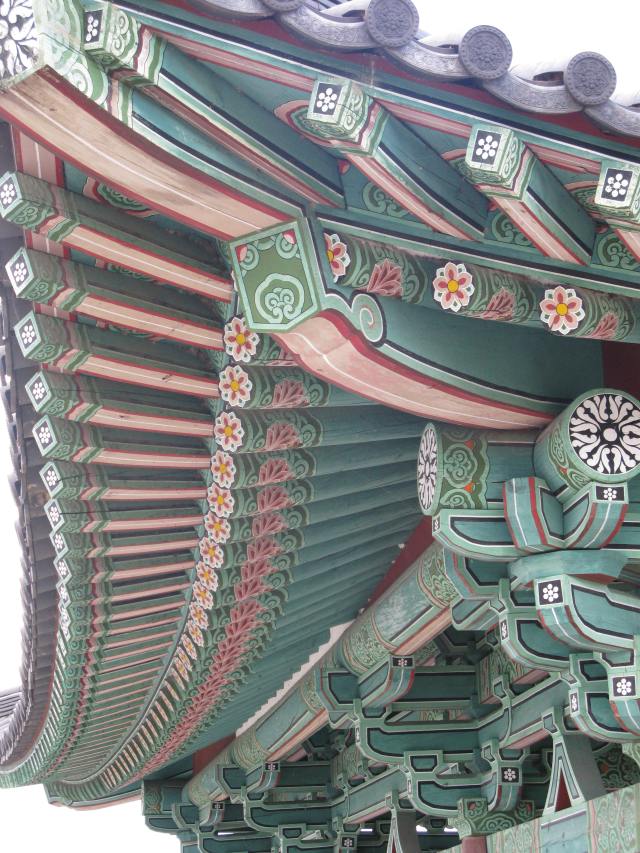
For those looking to try something slightly more modern I have a couple of suggestions for you that are both located just outside the main city centre and can be reached by taxi in around 20 – 30 minutes.
The first of these is the Gyeongju Botanical Garden and Bird Park located off Bomum-ro to the east of the city centre.
You have three options for tickets here. Just the Bird Park (17,000 Won per adult – around £11.50), just the Botanical Garden (5,000 Won per adult – around £3.50) or the combined ticket (18,000 Won per adult – around £12.20). Despite the combined ticket being the best value, Joe and I only had time to go to the Bird Park so we stumped up the cash at the ticket booth and headed towards the bird-nest shaped aviary.
The Park is spread across two floors but the main attractions are based on floor one. This spacious area is home to many species of bird (both large and small) as well as a reptile house and aquarium.
Joe and I enjoyed exploring the bird enclosures. The birds appear to be well looked after here and enjoy a fair amount of space also.
There is also an outside area where some of the larger, flightless birds (like the emu and ostrich) are housed as well as an enclosed section where you can go in with a number of smaller birds that are accustomed to human interaction.
I’d highly recommend you pay a few Won to buy some bird seed as you can go into this section. Joe and I did so and as soon as we had some seed in our hands, swarms of birds landed on our heads, arms, hands and shoulders waiting for their turn for a treat.
Be aware, that if you are slightly nervous around birds then this may be too much for you as some confuse things like your ears for bird food and have a bit of a peck at you. It doesn’t hurt much but it can be a bit of a surprise.
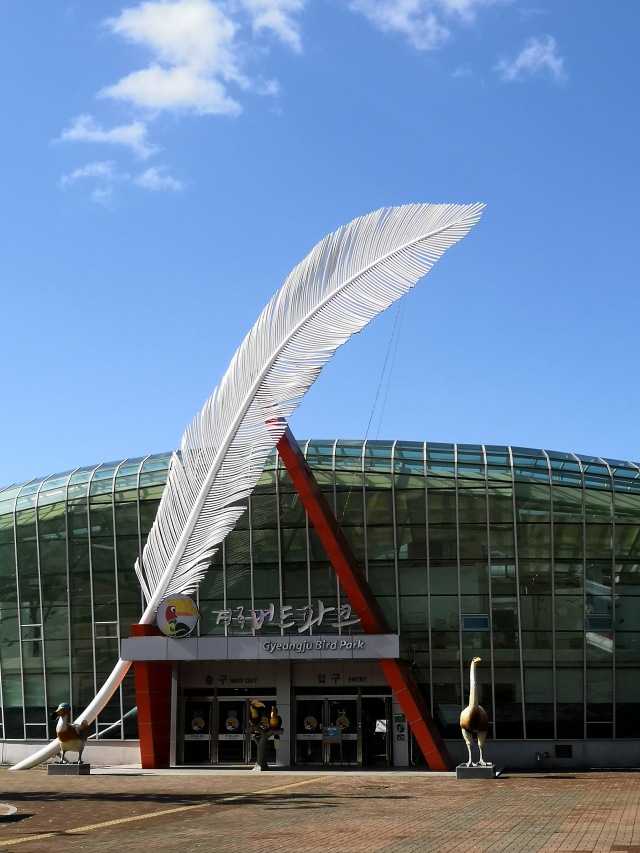
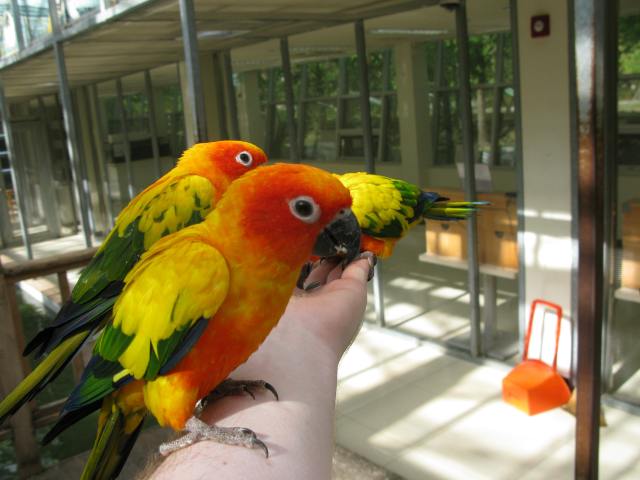
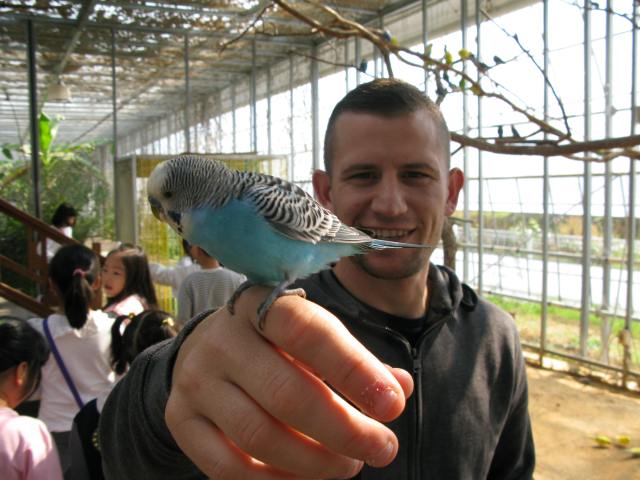
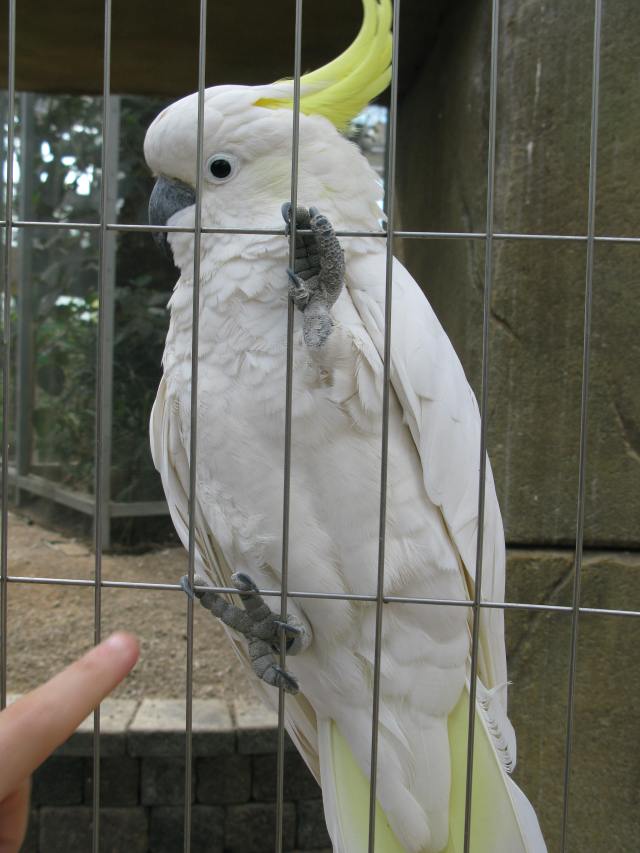
My final family fun-filled stop is just a bit further down Bomun-ro. Here travellers will find the exciting Gyeongju World theme park.
Now this may not be the biggest theme park in the world but it is the largest theme park in the southern area of Korea.
Gyeongju World is split into four main areas. The first two are the Snow Sled Garden (which is really only operational in the winter months), and the Wizard Garden (which is aimed at children).
The park’s most popular facilities are its third and forth area called X-Zone and Draken Valley. Here you’ll find the main roller-coasters Phaethon and Draken, as well as other thrill rides including Mega Drop, Tornado, Grand Canyon, King Viking and Submarine Splash.
On previous trips to Asian theme parks, I had found them to be less well organised than their north American cousins, but this park didn’t fall into that category. Queue times were modest with no queue seeming to last over an hour as well as keeping you well entertained as you went around.
Over the years, Joe and I have enjoyed many theme parks together; both in the UK and in America. We have got our system of getting on the biggest rides first down to a fine art and we made sure we carried this on in South Korea too.
Personal favourites here were Draken which is a great example of a dive coaster and the Mega Drop which takes you about 70m above the ground and then, as the name suggests, drops you!
Entrance fees are split into two main categories. There is the Admission Ticket (which doesn’t get you on any rides but is a great cheaper alternative for people who don’t enjoy theme park rides) which costs 26,000 Won per adult (about £17.50) or the Free Pass which, despite it’s name, costs 47,000 Won per adult (about £32) and gets you on all the rides as many times as you can handle.


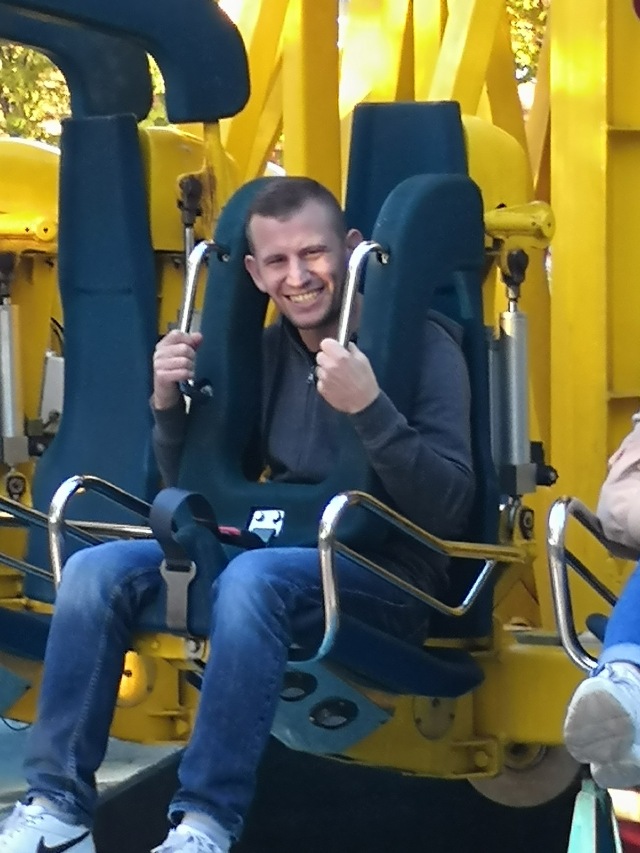

For more helpful information about Gyeongju, visit the tourist information websites Gyeongju Go and Visit Korea which are available in Korean and English.
Where to avoid
From experience, I’d say bars in general (in Gyeongju at least) are best avoided. Sadly, Joe and I didn’t have the best experiences here when we tried to go out and have a quiet drink of an evening.
While I state from the off we clearly didn’t try every bar – or drinking establishment – in Gyeongju, and I’m positive plenty of places don’t adopt this policy, 100% of the bars we did try to go into point-blank refused to let us in.
Again this could be for a variety of reasons. Some may genuinely have been too full for anymore customers (a lot of bars in the area looked very small), but some just didn’t want foreigners drinking in their establishments.
There was one bar in particular Joe and I tried to go into in Gyeongju. Whilst I cannot recall its name, it was located down a set of stairs in a side street. The stairway was dimly lit and looked slightly ominous anyway, but as there were two of us we thought we’d chance it, hoping that what was inside was nicer.
When we got to the bottom of the stairs we were met by three or four Korean men on a reception area who clearly were surprised to see us. We asked if we could come in and one of the men put his hands up in front of himself in the shape of an X saying there was no more room inside. This didn’t look likely as, from what we could see, the bar was almost empty. We asked again if we could just have one drink and this time a different man said quite sternly, in broken English, ‘no foreigners allowed. Korean bar only!’
I’ll be honest, as a white male, this was the first time in my life I felt I was being discriminated against simply because of my skin colour. It didn’t sit well with me at all. Given current world events (The Black Lives Matter movement for example) I can start to understand how if you’re subject to this type of behaviour, or much worse, on a daily basis that it can lead to resentment and anger.
Sheepishly, Joe and I left the reception area and headed back up to the street. Neither of us were quite sure what had just happened and it was only really on the way back to our hotel that we understood it more.
Overall, we must have tried five or six places and we never got past the front door on any of them.
So while the majority of Korean people we met over the trip were extremely welcoming, we also did see this slightly unsavory and backwards approach to foreign people still unfortunatley appearing to be alive and well.
Perhaps, in bigger city’s like Seoul – where they’re more familiar to western faces – this type of behaviour is less acceptable? But in smaller locations, where fewer travellers venture, there is still an undercurrent of cultural nonacceptance that sadly lets the country down slightly.
Great places to eat
While places to drink that will allow foreign faces to frequent their establishments are difficult to find, the same is not true for places to eat.
There is a plethora of eating opportunities to sample across South Korea in general, and Gyeongju is no exception to this.
There are lots of restaurants offering favourite Korean dishes including Hoeddeok (sweet syrupy pancakes), Japchae (stir-fried noodles) and Bibimbap (mixed rice) and, from experience, all of which provide a great local twist on these popular meals.
You’ll also have to look pretty far if you don’t want to find a portion of Kimchi (fermented vegetables) to the side of your dish. It comes with everything! At first, this fermented dish, often using cabbage, takes some getting use to. Yet, over time, I grew an appreciation for it and now see how it adds flavour to other dishes. Stick with it and give it a fair try is my best advice here. It’s an acquired taste.
You’ll also need to give chopsticks a go. Most restaurants in Gyeongju only provided chopsticks, and again, once you are familiar with them, you can eat quite happily. If you are really struggling, however, and fear that you’ll go hungry as the rice simply won’t stay between the sticks, most places will have knives and forks available if you ask for them.
During our stay in Gyeongju, Joe and I ate in a number of nice places whose names I cannot recall. Often restaurants appear by the side of the road and look like we were going to be entering someone’s house. Perhaps in a few cases we were!



Most Korean meals were presented to us across numerous dishes that were placed between us to share. This is normal in Asian culture as is kneeling on the floor to eat. Don’t be put off trying a bit of everything and throwing yourself head-first into this culinary experience.
A final mention should also be made to the wonderful traditional tearooms that you can find around the city. For me the best one we came across was located down Poseok-ro 1092beon-gil that we found while out exploring on our rented bikes.


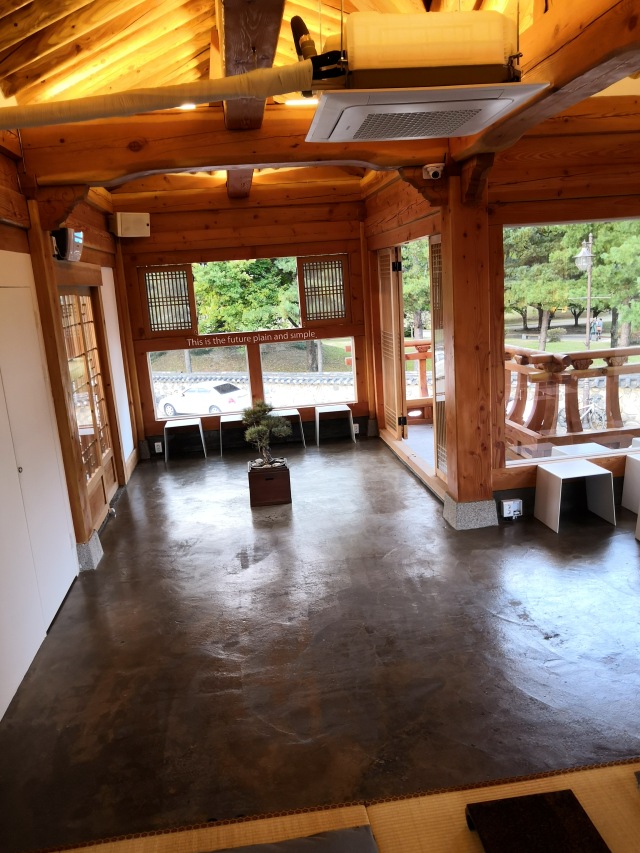
The tearoom we went in to looked like a traditional Korean house and we went in to the downstairs section to order our drinks. Once we’d ordered and collected our tea, we then carried it outside and up a set of stairs to a tatami-filled room where nobody else was. Here we were able to sit back and enjoyed our drinks. It was a far stretch from a Starbucks experience and that is a good thing. After all, if you’re like me, you don’t go to South Korea and beautiful cities like Gyeongju to drink cappuccinos from plastic cups!
My one bit of advice when approaching new food in Korea is to go into it with an open mind. Most dishes Joe and I ate were delicious even if initially they didn’t look too appetising. Be brave and dive in. It could open your eyes up to a whole new way of food appreciation.
Useful links
Donggung Palace and Wolji Pond
Gyeongju Botanical Garden and Bird Park
Remember you can follow World Complete on Twitter, Instagram, Pintrest, Tumblr and Facebook send your comments and pictures from your travels using #WorldComplete and #Travel.


Enjoyed this detailed post documenting your stay in Gyeongju, thanks for bringing it to my attention,
LikeLiked by 1 person
Thanks so much for stopping by and taking the time to read and comment. Hope you will enjoy some of my other blogs on this site also!
LikeLiked by 2 people
I’m glad you got to South Korea. I found it to be a fascinating, friendly and safe country. The language is very interesting to learn, and beautiful to listen to. And I loved the food!
I’m pleased to see you enjoyed the place too.
LikeLiked by 1 person
South Korea was an amazing experience. So glad I went. Please stop by World-Complete.com again and look at some of my other blogs when you have time
LikeLike
You definitely sold me on coming here, love your pictures!
LikeLiked by 1 person
Thanks so much. Glad you enjoyed the blog. Make sure you follow it for future updates
LikeLike
I enjoyed reading your post very much.
LikeLiked by 1 person
Thank you for your kind comments
LikeLike
Nice detailed article with good pics and information
LikeLike
Really good article, I appreciate the detail. Thanks for sharing your experiences at Gyeongju with us!
LikeLiked by 1 person
Kudos! Very comprehensive article. I have plans visiting Korea in the future. I love the palaces and old villages. I eat Korean food but I’m a mild spicy eater… that was an awesome trip except for the bars…
LikeLiked by 1 person
Thanks. Glad you enjoyed the blog. Yeah the bars were not a great experience but the rest of the trip to Korea was amazing. You’ll love it.
LikeLiked by 1 person
Thank you for sharing. I think I just visited South Korea virtually haha 🙂
COT | changeoftomorrow.com
LikeLiked by 1 person
Hope you enjoyed your virtual tour 😊 thanks for stopping by
LikeLike
Super informative post, thanks for sharing! It’s somewhere I’d love to go, especially since meeting new friends from South Korea on a trip last year, but the language barrier has put me off so far. Although, there’s always Google Translate!
LikeLiked by 1 person
I won’t lie, the language is an issue for most (including me) when you are there. However, it is possible to get about if you plan well in advance before you leave and have routes sorted out. You’ll love it, trust me. Thanks for stopping by 🙂
LikeLike
I went to South Korea 32(!) years ago. Your post triggered some great memories for me 🙂
LikeLiked by 1 person
The more I see of and read about South Korea, the more I feel a trip there would provide an interesting slant on our North Korea experiences. Much looks the same – the historic architecture (although the North has relatively little left after the war), the food. But much is different – your hotel room looks far superior to most of those we stayed in (there were two notable exceptions, but even then the beds weren’t very comfortable). And just the ability to go around and explore on your own is such a contrast to the North! It’s a shame you had those unpleasant experiences trying to go for a drink however.
LikeLiked by 1 person
South Korea was a great experience. I’d highly recommend it. I can understand it being a lot different to a trip to the North. The idea of going out on your own and cycling around the city must be such an alien concept to travel in North Korea. If / when you get the chance to visit the south Gyeongju is a fantastic place to get a feel for authentic South Korean life.
LikeLiked by 1 person